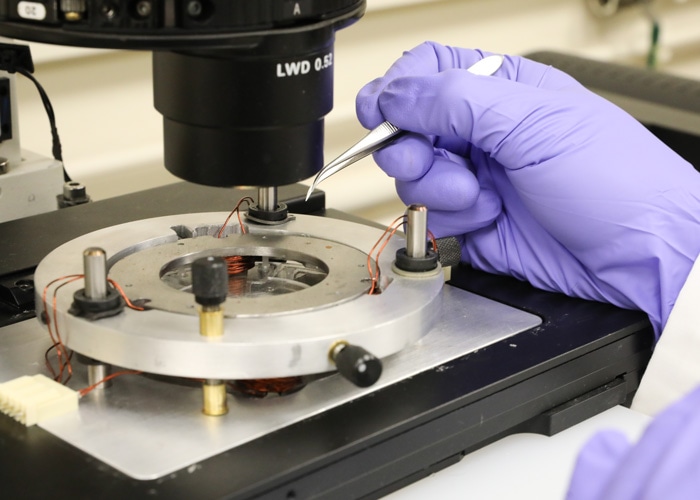Mar 14 2019
Researchers at the University of Toronto Engineering have developed a set of magnetic “tweezers” that can place a nano-scale bead inside a human cell in three dimensions with extraordinary precision. The nano-bot has already been employed to explore the properties of cancer cells, and could pave the way toward improved diagnosis and treatment.
 Wang’s system uses six magnetic coils (pictured) to control the position of a microscopic iron bead within the device. The bead is small enough to enter human cells and can be positioned with unprecedented accuracy. (Photo credit: Tyler Irving)
Wang’s system uses six magnetic coils (pictured) to control the position of a microscopic iron bead within the device. The bead is small enough to enter human cells and can be positioned with unprecedented accuracy. (Photo credit: Tyler Irving)
For twenty years, Professor Yu Sun (MIE, IBBME, ECE) and his team have been constructing robots that can control individual cells. Their designs have the capacity to control and measure single cells—beneficial in procedures such as in vitro fertilization and customized medicine. Their newest study, published recently in Science Robotics, pushes the technology a step further.
“So far, our robot has been exploring outside a building, touching the brick wall, and trying to figure out what’s going on inside,” says Sun. “We wanted to deploy a robot in the building and probe all the rooms and structures.”
The team has developed robotic systems that can work sub-cellular structures inside electron microscopes, but that necessitates freeze-drying the cells and cutting them into minute slices. To test live cells, other teams have used methods such as acoustics or lasers.
“Optical tweezers—using lasers to probe cells—is a popular approach,” says Xian Wang (MIE), the PhD candidate who carried out the study. The technology was bestowed the 2018 Nobel Prize in Physics, but Wang says the force that it can produce is not sufficiently large for mechanical control and measurement he aimed to achieve.
“You can try to increase the power to generate higher force, but you run the risk of damaging the sub-cellular components you’re trying to measure,” says Wang.
The system designed by Wang uses six magnetic coils positioned in various planes around a microscope coverslip filled with live cancer cells. A magnetic iron bead about 700 nm in diameter—about 100 times smaller than the thickness of a human hair—is positioned on the coverslip, where the cancer cells simply take it up inside their membranes.
After the bead is placed inside, Wang manipulates its position using immediate feedback from confocal microscopy imaging. He uses a computer-controlled algorithm to alter the electrical current through each of the coils, modeling the magnetic field in three dimensions and coaxing the bead into any preferred position within the cell.
We can control the position to within a couple of hundred nanometers down the Brownian motion limit. We can exert forces an order of magnitude higher than would be possible with lasers.
Xian Wang, PhD candidate, MIE, University of Toronto.
In partnership with Dr. Helen McNeil and Yonit Tsatskis at Mount Sinai Hospital and Dr. Sevan Hopyan at The Hospital for Sick Children (SickKids), the researchers used their robotic system to explore early-stage and later-stage bladder cancer cells.
Earlier studies on cell nuclei necessitated their extraction from cells. Wang and Sun measured cell nuclei in complete cells without having to break apart the cytoskeleton or cell membrane. They were able to demonstrate that the nucleus is not similarly stiff in all directions.
“It’s a bit like a football in shape—mechanically, it’s stiffer along one axis than the other,” says Sun. “We wouldn’t have known that without this new technique.”
They were also able to compute precisely how much stiffer the nucleus got when pushed repeatedly, and establish which cell protein or proteins may play a role in regulating this response. This insight could direct the way toward new approaches of diagnosing cancer.
“We know that in the later-stage cells, the stiffening response is not as strong,” says Wang. “In situations where early-stage cancer cells and later-stage cells don’t look very different morphologically, this provides another way of telling them apart.”
According to Sun, the study could expand even more.
You could imagine bringing in whole swarms of these nano-bots, and using them to either starve a tumour by blocking the blood vessels into the tumour, or destroy it directly via mechanical ablation. This would offer a way to treat cancers that are resistant to chemotherapy, radiotherapy, and immunotherapy.
Yu Sun Professor, MIE, IBBME, and ECE, University of Toronto.
These applications are, however, far away from clinical deployment, but Sun and his team are enthusiastic about the direction the research has taken. They are already involved in early animal experiments with Dr. Xi Huang in SickKids.
“It’s not quite ‘Fantastic Voyage’ yet,” Sun says, denoting the 1966 science fiction film. “But we have achieved unprecedented accuracy in position and force control. That’s a big part of what we need to get there, so stay tuned!”